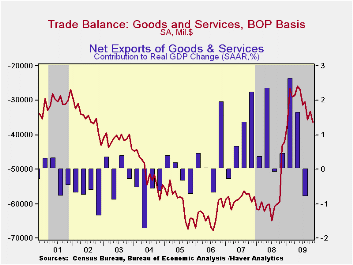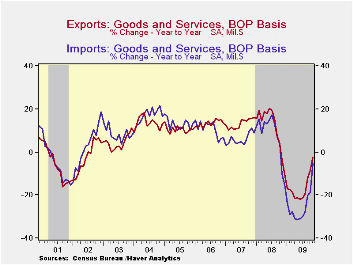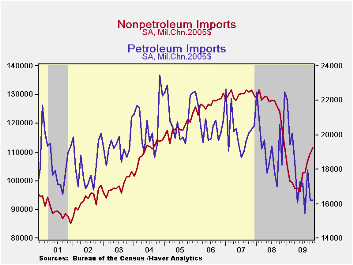 Global| Jan 12 2010
Global| Jan 12 2010U.S. Trade Deficit Increases With Economic Recovery
by:Tom Moeller
|in:Economy in Brief
Summary
Economic recovery hit the U.S. trade accounts with a double-whammy during November. It generated a 2.6% m/m rise in imports and it increased the international trade deficit to $36.4B which was the highest since January. The rise [...]
 Economic
recovery hit the U.S. trade accounts with a double-whammy during
November. It generated a 2.6% m/m rise in imports and it increased the
international trade deficit to $36.4B which was the highest since
January. The rise followed October's deficit of $33.2B which
was revised up slightly from the initial estimate. Export growth lagged
with a 0.9% increase that followed two months of stronger increase. The
latest figure was quite a bit higher than Consensus expectations for a
deficit of $34.5B.
Economic
recovery hit the U.S. trade accounts with a double-whammy during
November. It generated a 2.6% m/m rise in imports and it increased the
international trade deficit to $36.4B which was the highest since
January. The rise followed October's deficit of $33.2B which
was revised up slightly from the initial estimate. Export growth lagged
with a 0.9% increase that followed two months of stronger increase. The
latest figure was quite a bit higher than Consensus expectations for a
deficit of $34.5B.
Imports rose 2.6% in part due to a rise in crude
oil prices to $72.54 per barrel which was the highest level since
October of 2008. Overall, however, the gain in petroleum imports was
held back by a 4.6% m/m decline (-8.2% y/y) in the quantity of
energy-related products. U.S. economic recovery continued to be
apparent in a 1.5% increase (-6.3% y/y) in real nonoil imports which
was the fifth increase in six months. Real non-auto capital goods
imports jumped 3.5% (-13.0% y/y) after a 2.8% September rise. Real
nonauto consumer goods imports surged 3.7% and by 12.5% since June.
 These are turnarounds from earlier sharp declines. Real automotive
vehicles & parts imports, however, slipped 0.4% (-0.1% y/y) but
they were up by one-half since the spring. Real capital goods imports
also have been strong and rose 3.6% for the fourth increase in five
months. They have risen 14.5% since June. Finally, services imports
rose a modest 0.3% (-4.0% y/y) for the fifth increase in six months.
U.S. travels abroad were discouraged by the lower dollar. Travel
imports slipped 0.9% (-7.1% y/y and passenger fares rose 1.5% (-25.6%
y/y).
These are turnarounds from earlier sharp declines. Real automotive
vehicles & parts imports, however, slipped 0.4% (-0.1% y/y) but
they were up by one-half since the spring. Real capital goods imports
also have been strong and rose 3.6% for the fourth increase in five
months. They have risen 14.5% since June. Finally, services imports
rose a modest 0.3% (-4.0% y/y) for the fifth increase in six months.
U.S. travels abroad were discouraged by the lower dollar. Travel
imports slipped 0.9% (-7.1% y/y and passenger fares rose 1.5% (-25.6%
y/y).
Reflecting the competitive value of the dollar, nominal exports rose 0.9% m/m and by 13.6% from the April low. Adjusted for price inflation, however, the gain is more impressive. Though real merchandise exports slipped 0.6% during November (-4.4% y/y), they have risen 13.9% since April. Offsetting a 5.4% decline (-2.3% y/y) decline in real non-auto consumer goods exports was a 9.0% rise in auto exports (-6.1% y/y) and a 0.4% uptick (-7.6% y/y) uptick in real capital goods exports. Exports of services ticked up 0.2% (-0.8% y/y) following earlier strong monthly gains.
 By country, the trade deficit
with mainland China lessened to $20.2B, its least since June, as
exports rose 41.4% y/y and imports fell 2.5%. With Japan, the trade
deficit deteriorated to $5.4B from 5.1B one year earlier as exports
fell 16.3% while imports fell just 4.4%. With the European Union, the
trade deficit deteriorated to $6.4B as exports declined 9.4% y/y and
imports fell a lesser 5.3%.
By country, the trade deficit
with mainland China lessened to $20.2B, its least since June, as
exports rose 41.4% y/y and imports fell 2.5%. With Japan, the trade
deficit deteriorated to $5.4B from 5.1B one year earlier as exports
fell 16.3% while imports fell just 4.4%. With the European Union, the
trade deficit deteriorated to $6.4B as exports declined 9.4% y/y and
imports fell a lesser 5.3%.
The international trade data can be found in Haver's USECON database. Detailed figures are available in the USINT database.
The Determinants of International Flows of U.S. Currency from the Federal Reserve Bank of New York can be found here.
| Foreign Trade | November | October | September | Y/Y | 2008 | 2007 | 2006 |
|---|---|---|---|---|---|---|---|
| U.S. Trade Deficit | $36.4 | $33.2 | $35.7B | $43.2B (11/08) | $695.9 | $701.4 | $760.4 |
| Exports - Goods & Services | 0.9% | 2.7% | 2.8% | -2.3% | 11.2% | 13.2% | 13.3% |
| Imports - Goods & Services | 2.6% | 0.7% | 5.6% | -5.5% | 7.6 | 6.0% | 10.8% |
| Petroleum | 7.3% | -10.6% | 20.7% | 1.0% | 37.0% | 9.4% | 20.1% |
| Nonpetroleum Goods | 2.4% | 3.2% | 4.2% | -6.9% | 1.5% | 4.8% | 9.1% |
Tom Moeller
AuthorMore in Author Profile »Prior to joining Haver Analytics in 2000, Mr. Moeller worked as the Economist at Chancellor Capital Management from 1985 to 1999. There, he developed comprehensive economic forecasts and interpreted economic data for equity and fixed income portfolio managers. Also at Chancellor, Mr. Moeller worked as an equity analyst and was responsible for researching and rating companies in the economically sensitive automobile and housing industries for investment in Chancellor’s equity portfolio. Prior to joining Chancellor, Mr. Moeller was an Economist at Citibank from 1979 to 1984. He also analyzed pricing behavior in the metals industry for the Council on Wage and Price Stability in Washington, D.C. In 1999, Mr. Moeller received the award for most accurate forecast from the Forecasters' Club of New York. From 1990 to 1992 he was President of the New York Association for Business Economists. Mr. Moeller earned an M.B.A. in Finance from Fordham University, where he graduated in 1987. He holds a Bachelor of Arts in Economics from George Washington University.






